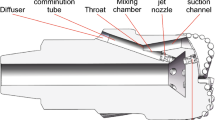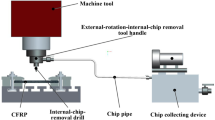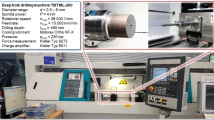Abstract
Chip evacuation is the main difficulty of deep hole drilling process. For deep hole drilling with large depth-to-diameter ratio over 10, drilling force increases significantly with the drilling depth due to the friction and pressure reaction between the continuing generated chips and the drill flutes as well as the hole wall. In practical deep hole drilling process, overlarge drilling depth will cause drill breakage due to the low rigidity of the deep-hole twist drill, while using too small drilling depth is inefficient. The existing methods for drilling depth optimization are still faced with troubles, including lack of prior knowledge input of the monitoring method and difficult to measure or calibrate model parameters of the prediction model. To overcome these problems, a novel and practical chip evacuation force model for deep hole drilling is developed in this paper. Firstly, the chip evacuation forces in deep hole drilling are derived based on the elemental chip flow method, with the expression including three chip evacuation force coefficients for the practicability of the model. Then, the chip evacuation force coefficients are calibrated in a set of drilling tests under different cutting parameters, and the relations between chip evacuation force coefficients and cutting parameters are investigated with range analysis and analysis of variance. Finally, validation experiment results show that the proposed chip evacuation force model is able to predict the drilling force with increasing drilling depth in deep hole drilling, and the maximum drilling depth can be obtained accurately with the error less than 3%.
Similar content being viewed by others
References
Portillo E, Cabanes I, Sánchez JA, Orive D, Ortega N, Marcos M (2012) A computer assistant for monitoring tool performance during the drilling process. Int J Comput Integr Manuf 25(9):829–838. https://doi.org/10.1080/0951192X.2012.671540
Kim H, Ahn J (2002) Chip disposal state monitoring in drilling using neural network based spindle motor power sensing. Int J Mach Tool Manu 42(10):1113–1119. https://doi.org/10.1016/S0890-6955(02)00059-7
Kirschner M, Michel S, Berger S, Biermann D, Debus J, Braukmann D, Bayer M (2018) In situ chip formation analyses in micro single-lip and twist deep hole drilling. Int J Adv Manuf Technol 95(5–8):2315–2324. https://doi.org/10.1007/s00170-017-1339-1
Aized T, Amjad M (2013) Quality improvement of deep-hole drilling process of AISI D2. Int J Adv Manuf Technol 69(9–12):2493–2503. https://doi.org/10.1007/s00170-013-5178-4
Khan SA, Nazir A, Mughal MP, Saleem MQ, Hussain A, Ghulam Z (2017) Deep hole drilling of AISI 1045 via high-speed steel twist drills: evaluation of tool wear and hole quality. Int J Adv Manuf Technol 93(1–4):1115–1125. https://doi.org/10.1007/s00170-017-0587-4
Kim DW, Lee YS, Park MS, Chu CN (2009) Tool life improvement by peck drilling and thrust force monitoring during deep-micro-hole drilling of steel. Int J Mach Tool Manu 49(3–4):246–255. https://doi.org/10.1016/j.ijmachtools.2008.11.005
Deng C, Chin J (2005) Hole roundness in deep-hole drilling as analysed by Taguchi methods. Int J Adv Manuf Technol 25(5–6):420–426. https://doi.org/10.1007/s00170-003-1825-5
Balaji M, Murthy B, Rao NM (2016) Multi response optimization of cutting parameters in drilling of AISI 304 stainless steels using response surface methodology. Proc IMechE B J Eng Manuf 232(1):151–161. https://doi.org/10.1177/0954405416636507
Ahmadi K, Altintas Y (2013) Stability of lateral, torsional and axial vibrations in drilling. Int J Mach Tool Manu 68:63–74. https://doi.org/10.1016/j.ijmachtools.2013.01.006
Mehrabadi IM, Nouri M, Madoliat R (2009) Investigating chatter vibration in deep drilling, including process damping and the gyroscopic effect. Int J Mach Tool Manu 49(12–13):939–946. https://doi.org/10.1016/j.ijmachtools.2009.06.009
Luo M, Luo H, Zhang D, Tang K (2018) Improving tool life in multi-axis milling of Ni-based superalloy with ball-end cutter based on the active cutting edge shift strategy. J Mater Process Technol 252:105–115. https://doi.org/10.1016/j.jmatprotec.2017.09.010
Song Q, Shi J, Liu Z, Wan Y (2017) A time-space discretization method in milling stability prediction of thin-walled component. Int J Adv Manuf Techol 89(9–12):2675–2689. https://doi.org/10.1007/s00170-016-9379-5
Mathew NT, Vijayaraghavan L (2017) Transformation and thickening of chip during high throughput drilling. Mater Manuf Process 32(15):1692–1699. https://doi.org/10.1080/10426914.2017.1328110
Heinemann R, Hinduja S, Barrow G, Petuelli G (2006) The performance of small diameter twist drills in deep-hole drilling. J Manuf Sci Eng-Trans ASME 128(4):884–892. https://doi.org/10.1115/1.2335859
Kavaratzis Y, Maiden JD (1990) Real time process monitoring and adaptive control during CNC deep hole drilling. Int J Prod Res 28(12):2201–2218. https://doi.org/10.1080/00207549008942862
Yao C, Tan L, Yang P, Zhang D (2018) Effects of tool orientation and surface curvature on surface integrity in ball end milling of TC17. Int J Adv Manuf Technol 94(5–8):1699–1710. https://doi.org/10.1007/s00170-017-0523-7
Mellinger JC, Ozdoganlar OB, Devor RE, Kapoor SG (2002) Modeling chip-evacuation forces and prediction of chip-clogging in drilling. J Manuf Sci Eng-Trans ASME 124(3):605–614. https://doi.org/10.1115/1.1473146
Mellinger JC, Ozdoganlar OB, Devor RE, Kapoor SG (2003) Modeling chip-evacuation forces in drilling for various flute geometries. J Manuf Sci Eng-Trans ASME 125(3):405–415. https://doi.org/10.1115/1.1578671
Choi YJ, Park MS, Chu CN (2008) Prediction of drill failure using features extraction in time and frequency domains of feed motor current. Int J Mach Tool Manu 48(1):29–39. https://doi.org/10.1016/j.ijmachtools.2007.08.009
Luo M, Luo H, Axinte D, Liu D, Mei J, Liao Z (2018) A wireless instrumented milling cutter system with embedded PVDF sensors. Mech Syst Signal Process 110:556–568. https://doi.org/10.1016/j.ymssp.2018.03.040
Jantunen E (2002) A summary of methods applied to tool condition monitoring in drilling. Int J Mach Tool Manu 42(9):997–1010. https://doi.org/10.1016/S0890-6955(02)00040-8
Tarng YS, Lee BY (1999) Amplitude demodulation of the induction motor current for the tool breakage detection in drilling operations. Robot Comput Integr Manuf 15(4):313–318. https://doi.org/10.1016/S0736-5845(99)00015-0
Kondo E, Shimana K (2012) Monitoring of prefailure phase and detection of tool breakage in micro-drilling operations. Procedia CIRP 1:581–586. https://doi.org/10.1016/j.procir.2012.04.103
Patra K, Jha AK, Szalay T, Ranjan J, Monostori L (2017) Artificial neural network based tool condition monitoring in micro mechanical peck drilling using thrust force signals. Precis Eng 48:279–291. https://doi.org/10.1016/j.precisioneng.2016.12.011
Liu G, Liu T, Gao Z (2013) Online detection and measurements of drill wear for the drilling of stainless steel parts. Int J Adv Manuf Technol 68(5–8):1015–1022. https://doi.org/10.1007/s00170-013-4892-2
Altintas Y (2012) Manufacturing automation: metal cutting mechanics, machine tool vibrations, and CNC design. Cambridge University Press, Cambridge
Kaymakci M, Kilic ZM, Altintas Y (2012) Unified cutting force model for turning, boring, drilling and milling operations. Int J Mach Tool Manu 54-55:34–45. https://doi.org/10.1016/j.ijmachtools.2011.12.008
Wu J, Wen J, Wang Z (2016) Study on the predicted model and experiment of drilling forces in drilling Ti6Al4V. J Braz Soc Mech Sci 38(2):465–472. https://doi.org/10.1007/s40430-014-0304-2
Ke F, Ni J, Stephenson DA (2006) Chip thickening in deep-hole drilling. Int J Mach Tool Manu 46(12–13):1500–1507. https://doi.org/10.1016/j.ijmachtools.2005.09.022
Anand RS, Patra K, Steiner M, Biermann D (2017) Mechanistic modeling of micro-drilling cutting forces. Int J Adv Manuf Technol 88(1–4):241–254. https://doi.org/10.1007/s00170-016-8632-2
Ahmadi K, Savilov A (2015) Modeling the mechanics and dynamics of arbitrary edge drills. Int J Mach Tool Manu 89:208–220. https://doi.org/10.1016/j.ijmachtools.2014.11.012
Sahu SK, Devor RE, Kapoor SG (2004) Modeling of forces for drills with chip-breaking grooves. J Manuf Sci Eng-Trans ASME 126(3):555–564. https://doi.org/10.1115/1.1763183
Heinemann R, Hinduja S, Barrow G (2007) Use of process signals for tool wear progression sensing in drilling small deep holes. Int J Adv Manuf Technol 33(3–4):243–250. https://doi.org/10.1007/s00170-006-0459-9
Heinemann R, Hinduja S (2012) A new strategy for tool condition monitoring of small diameter twist drills in deep-hole drilling. Int J Mach Tool Manu 52(1):69–76. https://doi.org/10.1016/j.ijmachtools.2011.09.002
Chandrasekharan V, Kapoor SG, DeVor RE (1998) A mechanistic model to predict the cutting force system for arbitrary drill point geometry. J Manuf Sci Eng-Trans ASME 120(3):563–570. https://doi.org/10.1115/1.2830160
Lukyanov AD, Onoyko TS, Najafabadi TA (2017) Optimization of processing conditions when drilling deep holes: twist drills. Procedia Engineering 206:427–431. https://doi.org/10.1016/j.proeng.2017.10.496
El-Wardany TI, Gao D, Elbestawi MA (1996) Tool condition monitoring in drilling using vibration signature analysis. Int J Mach Tool Manu 36(6):687–711. https://doi.org/10.1016/0890-6955(95)00058-5
Xiao W, Zi Y, Chen B, Li B, He Z (2014) A novel approach to machining condition monitoring of deep hole boring. Int J Mach Tool Manu 77:27–33. https://doi.org/10.1016/j.ijmachtools.2013.10.009
Funding
This study was co-supported by the National Science and Technology Major Project (Grant No. 2015ZX04001203) and the National Natural Science Foundation of China (Grant No. 51675438).
Author information
Authors and Affiliations
Corresponding author
Rights and permissions
About this article
Cite this article
Han, C., Zhang, D., Luo, M. et al. Chip evacuation force modelling for deep hole drilling with twist drills. Int J Adv Manuf Technol 98, 3091–3103 (2018). https://doi.org/10.1007/s00170-018-2488-6
Received:
Accepted:
Published:
Issue Date:
DOI: https://doi.org/10.1007/s00170-018-2488-6




